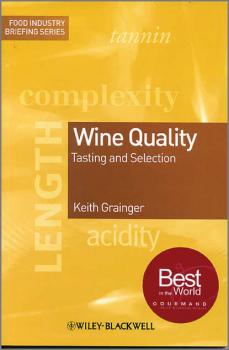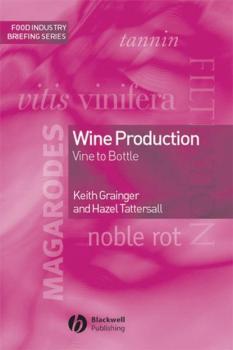Keith Grainger
Список книг автора Keith GraingerWine Quality
WINNER OF A GOURMAND WORLD COOKBOOK AWARD 2009! BEST WINE EDUCATION BOOK (THE BEST IN THE WORLD) «I really enjoyed this book … A constant feature of this book is how well Keith balances his mastery of the technicalities with a certain 'common touch', the ability to explain sometimes complex issues in easy-to-understand terms.» –Association of Wine Educators «… an ideal book to accompany a WSET course.» –Harpers Wine and Spirit Throughout the eight thousand years of vinous history wines have been tasted and their qualities examined in at least a basic way. Today producers can control the growing and winemaking processes, and the consumer may choose from a vast array of wines, both fine and ordinary. Tasting and evaluating these requires knowledge, skill and diligence. Part of the Wiley-Blackwell Food Industry Briefing Series, this book provides a concise, easy to use and clearly presented understanding of the techniques of wine tasting, quality assessment and evaluation. The reader is taken through the various stages of a structured and professional approach to tasting and the book examines the questions as to what constitutes quality in wines, how quality can be recognised and how it is achieved. Also discussed are the faults that can destroy wines at any quality level, and misconceptions as to quality and guarantees. Clearly presented and easily readable the book includes: Diagrams Tables Tasting vocabularies Colour Plates Written by Keith Grainger, highly regarded international wine educator and wine consultant, this book provides a concise, quick reference for busy wine industry professionals, students or others who wish to gain a detailed knowledge of the concepts of wine tasting and quality assessment. The Wiley-Blackwell Food Industry Briefing Series Devised to increase the effectiveness and efficiency with which knowledge can be gained of the many subject areas that constitute the food industry, and on which the industry relies for its existence, this important series is intended expressly to benefit executives, managers and supervisors within the industry. Each book distils the subject matter of the topic, providing its essence for easy and speedy assimilation.
Wine Production
The standard of wines made today is arguably higher than any time in the six thousand years of vinous history. The level of knowledge of producers and the ability to control the processes in wine production is also greatly improved. Authors Keith Grainger and Hazel Tattersall detail these processes, from vine to bottle, looking at key factors such as geography, winemaking techniques, the impact of decisions made upon style and quality, and problems that may be encountered. The authors are not afraid to discuss practices that may be regarded as controversial. Highly regarded consultants to the wine industry, Grainger and Tattersall present a clear and accessible handbook: Bullet points Vineyard and winery photographs Diagrams Text boxes Wine Production: Vine to Bottle is a concise and easy-to-use reference guide for all busy food and beverage industry professionals, students and others needing a working knowledge of wine production.
Wine Production and Quality
Gourmand Award for the No. 1 Best Wine Book in the World for Professionals Since the publication of Wine Production: Vine to Bottle (2005) and Wine Quality: Tasting and Selection (2009), there has been a great deal of change in the wine industry, and the perceptions of critics and expectations of consumers have shifted. Wine Production and Quality, Second Edition brings together its two predecessors in one updated and considerably expanded volume. This comprehensive guide explores the techniques of wine production in the vineyard and winery, and considers their impact upon the taste, style and quality of wine in the bottle. Part 1 of the book provides a structured yet easily readable understanding of wine production, from vine to bottle. The impact of natural factors, including climate and soil, is considered, together with the decisions made and work undertaken in the vineyard and winery. Part 2 looks at quality in wines: the concepts and techniques of tasting are detailed, along with the challenges in recognising and assessing quality. Also discussed are the steps producers may take, and the limitations they may face, in creating quality wines. The book will prove valuable to beverage industry professionals, wine trade students, wine merchants, sommeliers, restaurateurs , and wine lovers as well as those entering (or thinking of entering) the highly competitive world of wine production.


